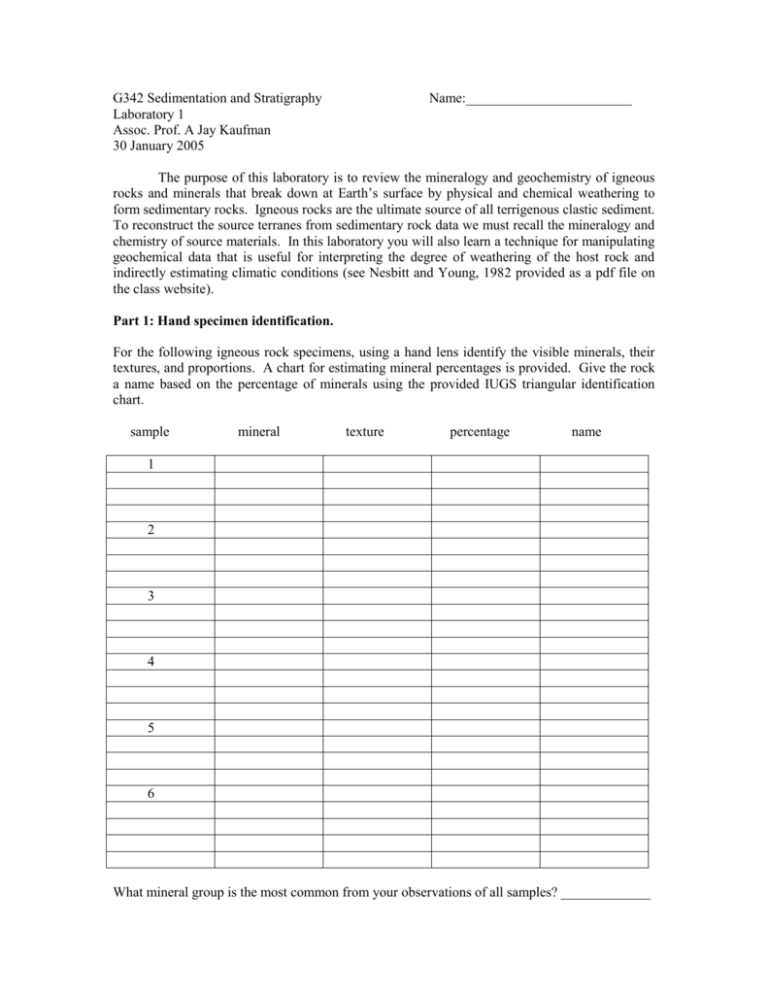January 30: CIA analysis
advertisement

G342 Sedimentation and Stratigraphy Laboratory 1 Assoc. Prof. A Jay Kaufman 30 January 2005 Name:________________________ The purpose of this laboratory is to review the mineralogy and geochemistry of igneous rocks and minerals that break down at Earth’s surface by physical and chemical weathering to form sedimentary rocks. Igneous rocks are the ultimate source of all terrigenous clastic sediment. To reconstruct the source terranes from sedimentary rock data we must recall the mineralogy and chemistry of source materials. In this laboratory you will also learn a technique for manipulating geochemical data that is useful for interpreting the degree of weathering of the host rock and indirectly estimating climatic conditions (see Nesbitt and Young, 1982 provided as a pdf file on the class website). Part 1: Hand specimen identification. For the following igneous rock specimens, using a hand lens identify the visible minerals, their textures, and proportions. A chart for estimating mineral percentages is provided. Give the rock a name based on the percentage of minerals using the provided IUGS triangular identification chart. sample mineral texture percentage name 1 2 3 4 5 6 What mineral group is the most common from your observations of all samples? _____________ Part 2: Geochemistry of igneous rocks It is valuable for geologists to plot the geochemistry of rocks on ternary diagrams to distinguish between various rock types. One of the diagrams that is of use to sedimentologists is called the A-CN-K triangle (from Nesbitt and Young, 1984; 1989). The apices of this triangle are ratios based on the equation for the chemical index of alteration (CIA) from Nesbitt and Young (1982). The “A” apex is derived from the calculation of CIA, which is based on the molecular proportions of major element oxides. CIA = [Al2O3/(Al2O3+CaO*+Na2O+K2O)] x 100 The molecular weights of the oxides must first be calculated from the atomic weights of the elements listed in the periodic table of the elements. 1) Determine the molecular weights of these oxides. SiO2 _____________________ TiO2 _____________________ Al2O3 _____________________ Fe2O3 _____________________ FeO _____________________ MnO _____________________ MgO _____________________ CaO _____________________ Na2O _____________________ K2O _____________________ P2O5 _____________________ CO2 _____________________ In the CIA equation, CaO* represents the CaO attributable only to silicates (essentially plagioclase). All non-silicate CaO must be subtracted. For igneous rocks (excluding carbonitites), the most abundant Ca-bearing phase is apatite [Ca5(PO4)3]. The correction to subtract the non-silicate CaO is: mol CaO* = mol CaO – mol CO2 – 10/3 mol P2O5 If CaO* equals a negative number then set it to unity in the equation. 2) From the data table reporting some important oxide abundance calculate CIA values for the following rock types and minerals. granite _____________________ granodiorite ____________________ tonalite _____________________ diorite _________________________ basalt ______________________ pure K-feldspar __________________ plagioclase __________________ 3) The final part of the laboratory is to plot the major element data for all these rocks and minerals in A-CN-K compositional space on the provided ternary diagram. To construct the plot it is necessary to figure out how to calculate the compositions of the three apices of the triangle. As noted above, the “A” apex is equal to CIA. Look carefully at the numerator and denominator of the CIA equation. From your inspection it should be possible to figure out the equations for the other two apices. List these below: A = [Al2O3/(Al2O3+CaO*+Na2O+K2O)] x 100 CN = _________________________________ K = __________________________________ Calculate the “CN” and “K” components using these equations of the rocks and minerals you calculated the “A” component for above granite: CN__________________ K ___________________ granodiorite: CN__________________ K ___________________ tonalite: CN__________________ K ___________________ diorite: CN__________________ K ___________________ basalt: CN__________________ K ___________________ K-feldspar: CN__________________ K ___________________ plagioclase: CN__________________ K ___________________ On the triangular diagram, plot and label each point using a different color or symbol. Draw the line that connects the composition of plagioclase and K-felspar. This line is referred to as the “feldspar join.” All points that lie on this line represent various mixtures of the two minerals. Note the positions of most of the rock compositions that you have plotted. Given this information, what two minerals dominate the continental crust? 1) __________________ 2) ___________________ What is the general CIA value for fresh crystalline basement rocks (excluding basalt)? ________ Note how plutonic rocks of different composition have unique positions in A-CN-K compositional space, but all have essentially the same CIA value. This indicates that fresh rocks spanning a wide variety of compositions have the same starting values. As a result one should be able to compare weathering histories (and sediments derived from weathering) from different areas regardless of initial starting compositions.






